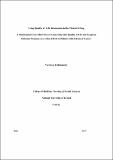| dc.contributor.advisor | Waldron, Dr Dympna | |
| dc.contributor.advisor | Mannion, Dr Eileen | |
| dc.contributor.author | McInerney, Veronica | |
| dc.date.accessioned | 2015-05-26T13:58:48Z | |
| dc.date.available | 2015-05-26T13:58:48Z | |
| dc.date.issued | 2015-05-25 | |
| dc.identifier.uri | http://hdl.handle.net/10379/4966 | |
| dc.description.abstract | While quality of life information has emerged as an important measure in assessing disease and treatment, its use as a tool to aide decision making in routine clinical practice in uncommon. This thesis examines the translation of quality of life measurements from concept to use in clinical practice. There is wide variability in the definition of quality of life and its conceptualisation. Many postulate that functional, health related attributes alone such as physical functioning are not entirely synonymous with quality of life, but suggest that quality of life is the degree of overall life satisfaction influenced by the individuals perception of aspects of life important to them, including matters both related and unrelated to health ( Moons et al.2004). The Schedule of Evaluation for Individual Quality of Life (SEIQoL) and SEIQoL Direct Weighting (SEIQoL DW) are measurement tools that capture the multidimensionality and uniqueness of the individual allowing him/her to define areas of importance to their quality of life and to demonstrate its measure of importance.
It is hypothesised that routine measurement of quality of life and symptom bother in patients followed by presentation of these measurements in a concise, succinct way that is easily interpreted by the clinician, may serve as a bridge to bring together the views of clinicians and patients to improve quality of life outcomes.
A randomised controlled trial of 65 patients receiving chemotherapy for advanced cancer was conducted to measure differences in perception of quality of life over 4 time-points in patients whose quality of life and symptom bother information was reported to the clinical team in info-graph format (intervention group) compared to patients whose quality of life information and symptom bother was not reported to the clinical team (control group).
The primary objective was to compare quality of life outcome and examine the differences in quality of life measurements between groups. Quality of life information was presented visually on an info graph for review by the clinical team at each time-point for participants in the intervention group. Quality of life information from the control group was not shared with the clinical team.
Results demonstrated improvement in quality of life of all patients from baseline to time point 4. (P=>0.05). However, closer examination of the discrete individual areas of importance to the patients (cues) showed interesting differences between the intervention and control group.
Participants in the intervention group demonstrated a 51% improvement in the perception of health functioning compared to 19% improvement in perception of health functioning in the control group (p=0.014).Paradoxically and interestingly, there was a decline in patient perception of functioning in other cues (social activity, keeping active and family support) with no significant difference between groups.
Symptom data also demonstrated patients in the intervention group experienced 10% reduction in symptom interference in their quality of life over time compared to patients in the control group who experienced a 38% increase in symptom interference in their quality of life from baseline to time point 4 (p=0.0000).
Results support the thesis that clinician awareness of individual patient quality of life values and functioning, along with awareness of the impact of bothersome symptoms, results in significant improvements in some aspects the patients quality of life. Conducting quality of life measurements with SEIQoL and using this information as a clinical tool is of benefit to the patient and can be successfully translated into routine clinical practice in an acute hospital setting .It heralds a supplementary stratum to personalized medicine. | en_US |
| dc.rights | Attribution-NonCommercial-NoDerivs 3.0 Ireland | |
| dc.rights.uri | https://creativecommons.org/licenses/by-nc-nd/3.0/ie/ | |
| dc.subject | Quality of life | en_US |
| dc.subject | SEIQoL | en_US |
| dc.subject | Advanced cancer | en_US |
| dc.subject | Clinical measurement tool | en_US |
| dc.subject | Medicine, Nursing & Health Sciences | en_US |
| dc.title | Using quality of life information in the clinical setting: a randomised controlled trial of using subjective quality of life and symptom outcome measures as a clinical tool in patients with advanced cancer | en_US |
| dc.type | Thesis | en_US |
| dc.contributor.funder | Educational Bursary recived from the Irish Hospice Foundation | en_US |
| dc.local.note | Quality of life is influenced by an individuals values and priorities in addition to health functioning. This research demonstrates that on-going clinician awareness of concerns affecting the quality of life of patients receiving chemotherapy for cancer leads to significant improvement in some aspects of the patients overall quality of life. | en_US |
| dc.local.final | Yes | en_US |
| nui.item.downloads | 1301 | |


